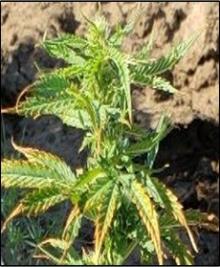By K. Frost and C. M. Ocamb
Cause Hop latent viroid (HLVd), a pathogenic circular RNA particle, has been confirmed in hemp plants. HLVd is a common viroid in hop and is ubiquitous in hop yards in the Pacific Northwest where it only produces known symptoms on a few hop varieties such as Omega. This viroid can also infect the stinging nettle (Urtica dioica). Hop latent viroid was first found associated with cannabis in California. Generally, data are lacking regarding the extent and incidence levels of HLVd in cannabis across the Western US and Canada. 90% of cannabis-growing facilities in California were found to be infected with HLVd in a 2021 survey. Of nearly 16,000 cannabis plant samples submitted to a diagnostic laboratory from provinces in Canada during 2020-2022, 26% tested positive for HLVd. This viroid has also been detected in hemp grown in Colorado and Washington. In 2021-2022 disease surveys that OSU conducted of 79 hemp production sites across Oregon and central Washington, HLVd was detected in eight Oregon and two Washington sites. During 2019-2020, HLVd was found in 15/36 hemp samples at the OSU Plant Clinic in Northeastern Oregon and in two fields in Washington during 2021-2022.
Little is known about epidemiology of this disease in hemp or hop, but in hop, the viroid is reportedly spread mechanically during propagation, field operations, and to a limited degree by plant-to-plant contact and seed transmission. There is no evidence that this viroid is transmitted by insects. Recent evidence has been reported that HLVd can be seedborne in hemp. This pathogen can be spread through vegetative propagation (i.e., taking cuttings from an infected mother plant) as well as through seed produced using either infected mother plants or infected pollen. This viroid causes dudding disease in cannabis production but not all varieties are symptomatic.
Symptoms HLVd-infected hemp plants may remain asymptomatic or may exhibit stunting, smaller leaves, shorter internodes, chlorosis, and brittle stems. In the field, symptoms in early growth stages are often asymptomatic or may resemble a nitrogen, deficiency. Plants infected in early growth stages may be stunted and appear to grow out of the disease as the season progresses. It is unknown whether HLVd can affect the chemical composition of hemp varieties, but in cannabis it known to reduce flower mass and trichomes as well as reduce cannabinoid and terpene production.
Cultural control Exclusion and sanitation are important means of viroid control.
- Use viroid-tested stock certified to be free of viroids.
- Plant where hemp or hop have not been grown before.
- Avoid circulation of solutions among plants grown in hydroponic or soilless systems. At the minimum, use separate tanks for hemp seedlings.
- Remove any infected plants.
- For propagation, heat blades at 320°F for 10 min between plants. Tool sanitation with 25% bleach and 20% dried skim milk were very helpful at inactivation of a different viroid disease (potato spindle tuber viroid), but only the skim milk treatment was effective at degrading the nucleic acids of the potato spindle tuber viroid, ensuring that the viroid particles were no longer infective.
- Practice general sanitation for disease control. Clean equipment between fields, particularly during early season operations.
References Adkar-Purushothama, C. R., Sano, T., Perreault, J.-P. 2023. Hop latent viroid: A hidden threat to the cannabis industry. Viruses 15: doi.org/10.3390/v15030681.
Atallah, O. O., Yassin, S. M., and Verchot, J. 2024. New insights into hop latent viroid detection, infectivity, host range, and transmission. Viruses 16:doi.org/10.3390/v16010030.
Bektaş, A., Hardwick, K. M., Waterman, K., and Kristof, J. 2019. Occurrence of hop latent viroid in Cannabis sativa with symptoms of cannabis stunting disease in California. Plant Disease 103(10):DOI.org/10.1094/PDIS-03-19-0459-PDN.
Eastwell, K.C. and Nelson, M.E. 2007. Occurrence of viroids in commercial hop (Humulus lupulus L.) production areas of Washington State. Plant Health Progress doi:10.1094/PHP-2007-1127-01-RS.
Jarugula, S., Wagstaff, C., Mitra, A., Crowder, D.W., Gang, D.R., and Naidu, R.A. 2023. First reports of beet curly top virus, citrus yellow vein-associated virus, and hop latent viroid in industrial hemp (Cannabis sativa) in Washington State. Plant Disease107:2897. https://doi.org/10.1094/PDIS-12-22-2981-PDN
Mackie, A. E., Coutts, B. A., Barbetti, M. J., Rodoni, B. C., McKirdy, S. J., and Jones, R. A. C. 2015. Potato spindle tuber viroid: Stability on common surfaces and inactivation with disinfectants. Plant Dis. 99:770-775.
Punja, Z.K., Wang, K., Lung, S., and Buirs, L. 2024. Symptomology, prevalence, and impact of hop latent viroid on greenhouse-grown cannabis (Cannabis sativa L.) plants in Canada. Can. J. Plant Pathol. 46:174-197. https://doi.org/10.1080/07060661.2023.2279184
Rivedal, H.M., Funke, C.N., and Frost, K.E. 2022. An overview of pathogens associated with biotic stresses in hemp crops in Oregon, 2019 to 2020. Plant Disease 106:1334-1340. https://doi.org/10.1094/PDIS-11-21-2415-SR
Warren J.G., Mercado, J., and Grace, D. 2019. Occurrence of hop latent viroid causing disease in Cannabis sativa in California. Plant Disease 103:2699-2699. https://apsjournals.apsnet.org/doi/full/10.1094/PDIS-03-19-0530-PDN




